
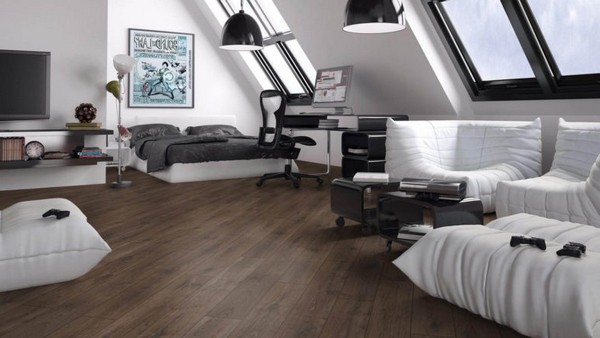
Selecting flooring for a house or apartment is a rather long and painstaking process. It is important to choose a material that doesn’t only correspond to all the style aspects of the room but is also long-lasting. Currently, there are multiple selections of flooring products, so selecting a material that fits with your style and budget should be easy.
However, over the past few years, laminate has established itself as the most popular flooring. This popularity is mainly because laminate boards have a large number of advantages compared to other analogs. Invented towards the end of the 1970s, laminate choices have grown to include various shades and textures at a price affordable to every customer. However, before settling on a particular type of laminate, it is important to understand the different types that exist, as well as their pros and cons.
What is laminate flooring?
As one of the most famous and most optimal options for flooring, laminate is an artificial floor surface consisting of many layers. The base of laminate boards is essentially specially processed boards made from fiberboard or chipboard.
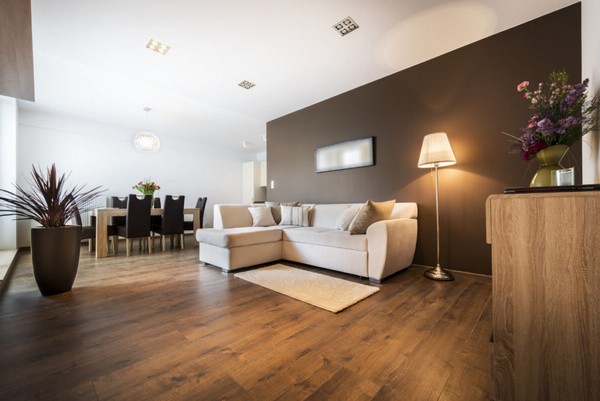
Thanks to the introduction of innovative technologies, modern manufacturers have been able to develop the optimal laminate design, featuring an attractive exterior and a satisfactory service life. High-quality laminate floors consist of four main layers, each of which performs a separate function as explained below:
- The top layer is a protective coating. It consists of a specially developed and sufficiently durable acrylic resin and has a thickness of half a centimeter. The use of such composite materials can guarantee a greater degree of protection of the external decorative layer of the laminate from color erasure, various chemical and mechanical damage, moisture, exposure to sunlight, etc. To further increase the functional properties of this layer, popular brands have recently begun to use powerful electron beams in the production process.
- A decorative layer that is made of special paper. Most often, the layer imitates various types of wood. However, in some collections of popular brands, you can find laminate where the outer layer mimics other materials, such as stone and metal. Due to this diversity of the decorative layer, laminate flooring has won great popularity among buyers. The presence of both light and dark shades and a wide variety of textures allows laminate flooring to be used with any design style.
- The main layer, which consists of a fairly dense plate of chipboard or fiberboard. The functional features of this layer are important in determining the quality of the entire board. This layer immensely influences the overall strength, resistance to moisture and damage and the floor’s ability to withstand high loads. Also, the main layer is responsible for heat and sound insulation, while also increasing the bonding of the boards to each other. This layer ranges between 5 and 10 millimeters in thickness.
- The bottom layer is composed of melamine. Its main function is to repel water and protect the entire floor from damage. Some models are equipped with additional sheets of melamine, which give the laminate boards even greater reliability.
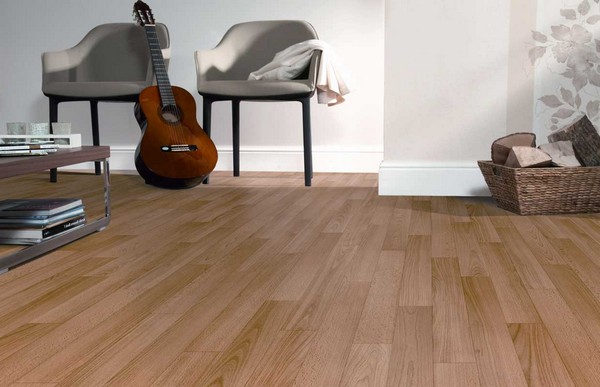
Due to the use of sufficiently strong pressure and high temperatures during the production of laminate, all of the above layers are seamlessly connected into a single panel. The quality of the finished product will depend on the materials used by a particular manufacturer, and the cost, in turn, will depend on the quality of the product. The properties of the laminate are based on an integrated approach, which is used even at the production stage. All of the above layers together allow the laminate to beautifully cover the floor for years.
Laminate benefits
We have already stated that one of the advantages of this flooring is the wide range that specialized shops provide. However, this is only one of several advantages of laminate flooring. Among other equally important advantages are the following:
- High durability: While shopping for laminate flooring, you are most likely to find boards of high classes (from 31 and above).Such floors can withstand even the highest loads, making them flexible for use not just in residential premises, but also in shopping centers, entertainment complexes, beauty salons, and gyms.
- The wear resistance of laminate is manifested in the fact that it is almost impossible for one to damage it. Due to the high protective properties of the top layer, laminate boards can resist both chemical and mechanical damage.
- A wide range of variations to choose from. The catalogs of most brands include collections of laminate boards made from wood, stone, leather and many other materials. All these options guarantee the installation of laminate flooring in a home of essentially any style, from classic to hi-tech.

- The materials used in the manufacture of laminate are not combustible. Therefore, the risk of fire in cases such as cigarettes or candles falling to the floor is minimal.
- Easy to maintain: Laminate flooring requires little maintenance. To get rid of unwanted stains or dust, you just need to wipe over the laminate with a damp cloth. In some cases, however, you may also need to use detergent.
- The moisture resistance of laminate makes it suited for homes even in areas with high humidity, as well as humid rooms like the bathroom and kitchen. Laminate floors in these environments can remain strong and attractive for a long time.
- The cost of laminate is another main advantage since laminate is affordable than many other floor options. Also, the affordability of laminate does not affect its quality, with some laminate floors serving for up to 30 years.
- The ease of installation is explained by the fact that modern manufacturers use specially designed locking systems. Thus, even a person who does not have sufficient experience in this field can connect the boards.
Classification of laminate boards — Types and classes
Depending on the specific features, the wide range of laminate flooring can be grouped into specific groups. Most often, laminate is classified according to the following aspects:
- Appearance;
- Type of connection between the boards;
- Wear resistance class;
Paying attention to all of the above characteristics, you can easily choose a laminate covering that will fit perfectly into your home, satisfying your taste and preferences.
Product appearance
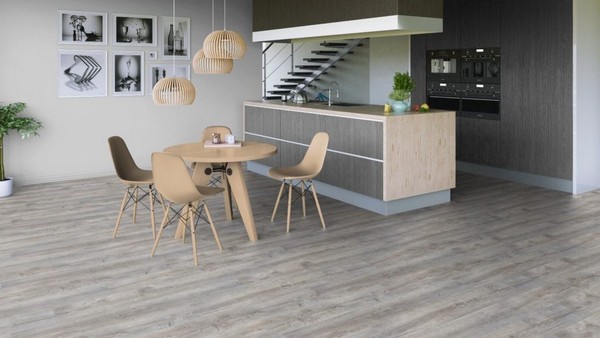
The appearance of the laminate is one of the first qualities you should consider when shopping for a laminate floor.
Often, buyers are unaware of the functional properties of various laminate boards, so their selection is often limited by the texture and shade of the laminate. However, choosing the perfect laminate flooring can also be confusing, particularly since retailers offer so many different varieties. Often, you will find laminate panels that mimic the following materials:
- Natural wood: Initially, laminate was developed as a cheaper alternative to parquet, which was highly popular at the time of laminate’s invention. For this reason, many manufacturers have focused on producing laminate that mimics different types of wood, from oak to birch and pine. Modern technology has made it possible to produce laminate boards that are almost indistinguishable from natural parquet, perfectly imitating the cut and shade of different types of wood.
- Stone: The second most popular design option for laminate is stone. The advantage of this variant of laminate is that, unlike natural stone, which is quite cold to the touch and is costly, laminate panels not only give the appearance of natural stone but are also quite comfortable.
- Metal: Metal is mostly used as flooring for homes with modern styles. Metal-themed laminate does not just cover the floor but also serves as a type of decor element and the highlight of the house. Metal laminate is mainly installed in the kitchen because it blends in perfectly with large household appliances, many of which have metal inserts. As a result, the appliances harmonize and complement the metal laminate in every possible way.
- Hide: Hide is one of the most original variations in the design of the laminate board. Although this type of floor can look rather bulky, with the right approach, it will smoothly fit into the interior, becoming the highlight of the room. This type of laminate is mainly used when designing a home office or library.

Type of connection between boards
Based on how the laminate is laid, the boards can be connected using:
- Glue
- Castle.
Over the last few years, the adhesive method of attaching laminate panels is fading away. This is because such an installation takes a lot of time, yet the result is rarely good. Also, this method of joining boards is not recommended for use in children’s rooms, since the chemicals in the glue can be harmful when inhaled.
Therefore, as a solution, specialists have developed a special castle system, which is highly popular today. Due to their design, such boards are fast and easy to fasten together, saving time during installation. It should be noted that the castle laminate is a more reliable type of connection. What is more, such boards do not absorb moisture or dust and are safe, making them appropriate for use in different settings.
Laminate wear class
One of the most important characteristics of laminate is its resistance to wear. Currently, most retailers offer laminate in 21-23 and 31-33 classes. It is important to choose the laminate while assessing factors such as where you intend to install the laminate, i.e. in a residential or industrial room. If you plan to purchase a laminate board for an apartment or detached house, then the functional properties of laminate classes 21, 22 and 23 will serve you efficiently. These classes of laminate can withstand low or medium loads and are affordable.
Laminate class table
Still, you can go for the laminate of class 31 and above. This is because such models are universal and can be used in many different settings. Class 31 panels have a relatively low degree of load-bearing, which is why experts recommend installing them in rooms that do not have a lot of activity, such as the bedroom.
Class 32 of wear resistance of products can withstand more severe loads. That is why such a floor is ideal for the kitchen since the kitchen has large and heavy appliances. Class 33 models, on the other hand, are considered one of the strongest and highest quality floor coverings since they can withstand very strong loads. Due to their strength, this degree of laminate can be installed not only in residential buildings or apartments but also in large shopping and entertainment complexes, sports halls, catering establishments and other venues with high activity.
The use of laminate in different rooms: Rules of selection
We have discussed plenty of laminate flooring in the previous sections. However, in the following sections, we break down the details discussed above even further, making it even easier for you to select the laminate floor best suited for you.
Laminate in the bedroom
Many people spend a lot of time in the bedroom. Keeping in mind that the bedroom does not have large furniture or heavy appliances, you are free to choose the class of laminate you desire. However, you should also know that the laminate boards you choose should be able to withstand the fairly heavyweight of the bed.

The most organic flooring for the bedroom is laminate that imitates wood, like the one portrayed in the picture above. It is ideal if the wooden laminate corresponds to the wood used to create the bed. Regardless, you should also consider other pieces of furniture in the bedroom.
Since the bedroom mostly uses light tones, the laminate boards can be in both light and dark shades. Light-toned laminate elegantly complements the interior, while dark-toned laminate can act as a peculiar highlight of the room. If you decide to finish the bedroom in dark colors, then the designers recommend black or dark brown shades.
Living room
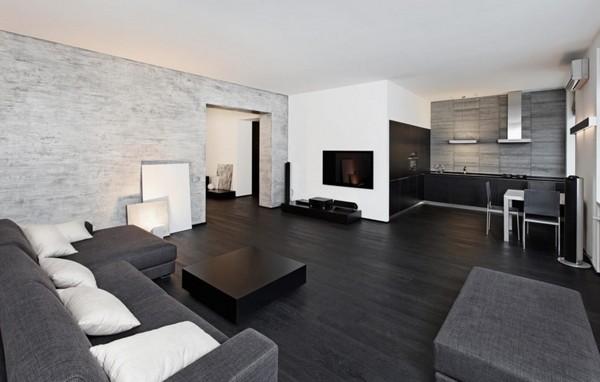
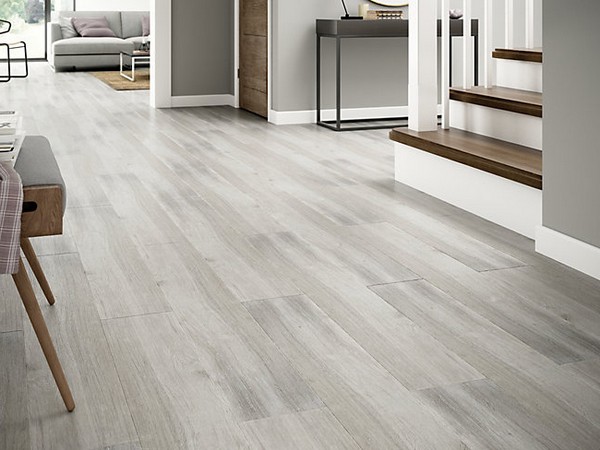

The living room is the central room for the family and guests. For a small living room, which combines several functional areas, it is best to choose a laminate that harmoniously combines all the different areas. Experts recommend installing light-colored laminate boards in the living room since they do not accumulate dirt easily. If your living room is combined with the kitchen, you should pay greater attention to the properties of the laminate, particularly the moisture resistance.
Another technique many designers use is the installation of dark flooring in a living room with light walls. With this contrast, a visual enlargement of space is achieved. This effect can also be achieved through the use of wide laminate boards.
Kitchen
One of the most popular kitchen design options is the contrasting of black and white, which is why many designers strongly recommend the use of a light-colored floor covering, as it will form an elegant background and will help to combine all the elements of the room. The same tip is often applied to the kitchen, which should ideally have bright accents in the form of multi-colored pieces of furniture or decor elements. In any case, the floor of the kitchen should act more as a background and look neutral, rather than being the focus of attention.

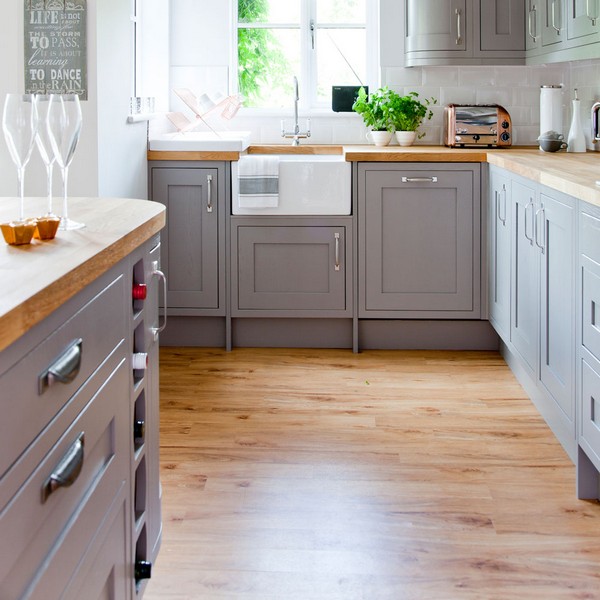
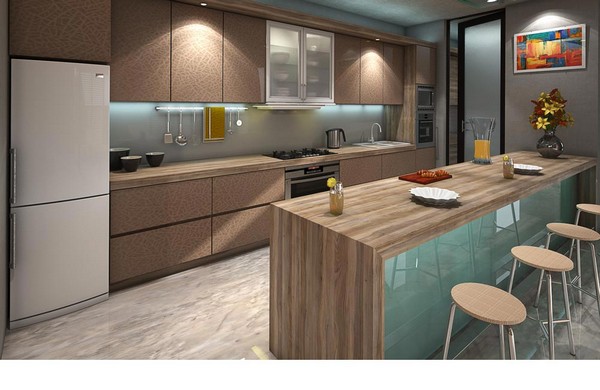
As you can see, there are many considerations for choosing the right laminate floor. Having carefully studied all of the above characteristics of laminate flooring, you can easily and accurately select the perfect laminate that will harmoniously and delightfully spruce up your home for a long time.


